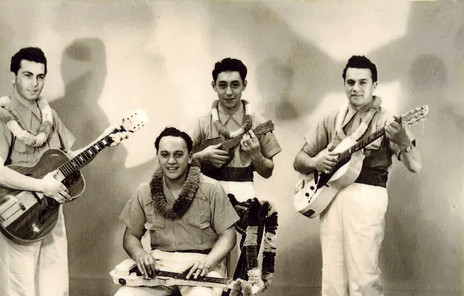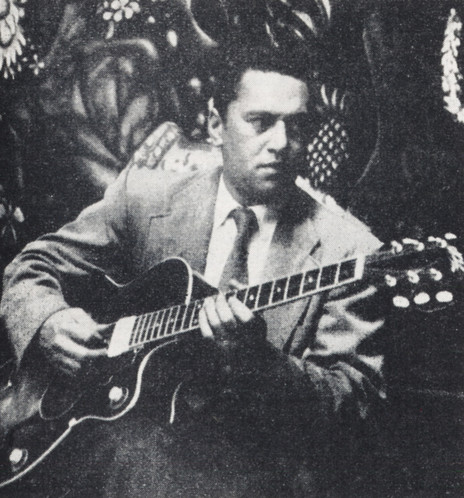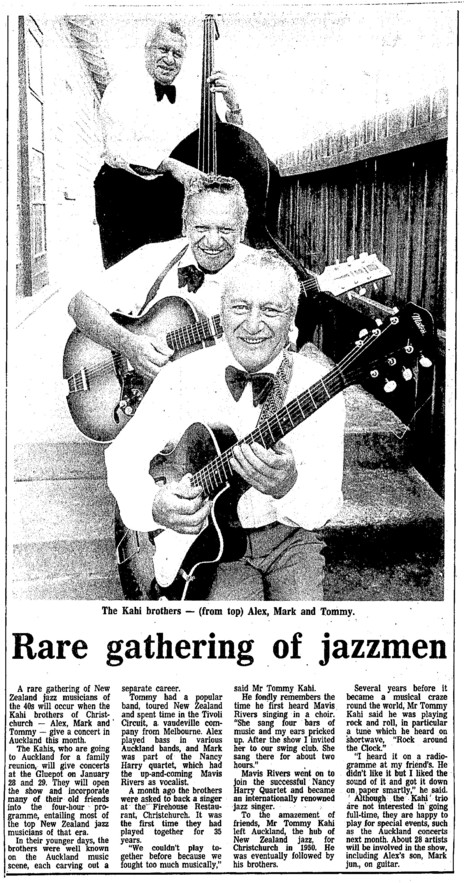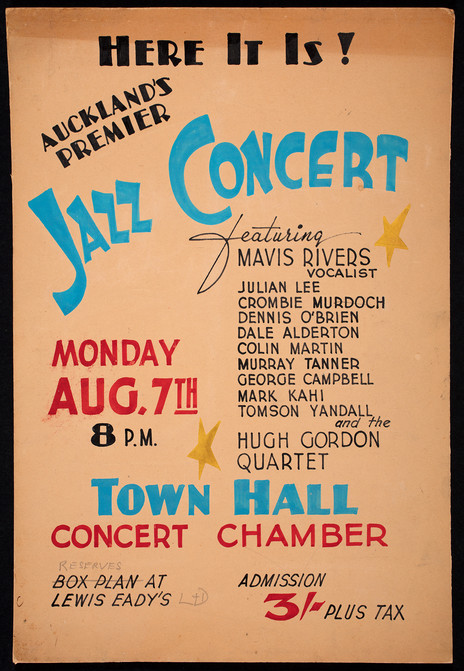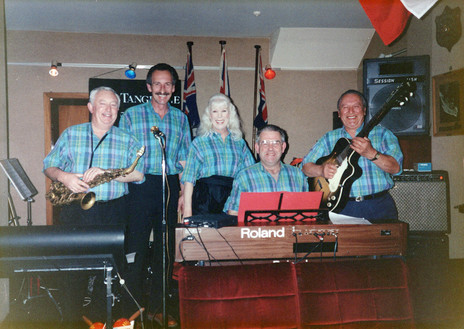The family moved to Auckland in the 1930s and Mark was sent to Nelson St School in Freemans Bay. One of his classmates was John Bradfield, and the pair of them would become Auckland’s most in-demand guitarists in the 1950s. Bradfield recalled that one day Mark Kahi suggested they go to the home of another schoolmate, Tom Wakelin, who had a guitar.
“I was about 12,” said Bradfield. “I hadn’t heard a guitar before then. Tom was getting guitar lessons from Walter Smith at the Lewis Eady music store. Mark would look and play it straight after.”
On a tribute show to Mark Kahi in 1999, on Jim Sutton’s Newstalk ZB Nostalgia programme, Wakelin said, “There was an occasion to take instruments to school and I took this old guitar, and Mark spotted it. We were friendly before but we became more so, because of the guitar.”
Wakelin was invited back to the Kahi home in Greys Avenue behind the Auckland Town Hall. “I’ve got Mark to thank for showing me my first bar chords – all I knew was three ukulele chords, and we got up there and Mark said ‘try these’ and it went from there. I can still remember the first tune we used to try, ‘Sweet Leilani’. Guitars weren’t easy to get in those days and we didn’t have a lot of money, being schoolkids. If you had a guitar it was some old thing somebody gave you.”
When Wakelin visited the Kahi home at Greys Avenue, he found the Kahi boys had made their own guitar. “They’d got a neck from somewhere and the body was three-ply.He’d show me these fancy chords, and instead of the notes ringing on, it would sound like the thump of a drum. As we got better guitars, Mark surged ahead. Every time you saw him, he had a new tune.”
Often Mark would jump over the back fence into Myers Park and sit on a handy tree limb practicing his guitar.
Another friend, Bryce Gregory – who lived nearby on Nelson Street – remembered Kahi as a superb athlete. “Mark stood out. He was not good academically but everyone else helped him out scholastically. He was good looking, well-built, athletic, easy going, a good mate.
“He was a sprint champion – put him on the wing playing rugby and you couldn’t catch him. When he swam, half his body was out of the water.
“He carried that speed into his music. You can go into music shops now and get videos and tapes showing you how to play every finger position. You couldn’t in those days.
“Those guys, Tom Wakelin, Mark, Johnny Bradfield, used to scrounge round to find new chord shapes. They’d go up to the Polynesian Club to watch seamen coming in from Philippines and United States playing gigs up there, and they’d ask ‘what chord was that?’
Mark Kahi “had a soul to his playing and he was the stand-out musician in those days”
“Other musicians were technically brilliant,” continued Gregory, “but Mark had a soul to his playing and he was the stand-out musician in those days, with a long way to the second best.”
The Polynesian Club on Karangahape Rd – a stone’s throw away from Greys Avenue – was run by Lou Mati, a Tahitian who also taught various stringed instruments. Mark started sitting in for the weekend dances – he said it was when he was 14 – and honed his craft on the bandstand.
During the war years Mark heard the sound that would shape his own direction: it was the Les Paul Trio playing ‘How High The Moon’. The song was on a V-Disc made for the American forces in Auckland, who had commandeered radio station 1ZM. In time Mark would come to be billed as “New Zealand’s Les Paul”.
Music publications of the era tracked Mark’s activities. The May 1949 issue of Australian Music Maker reports he brought the house down during an appearance with the Dale Alderton 1ZB Radio Theatre Show Band. “He’s the goods this boy,” wrote the AMM’s Auckland columnist Bert Peterson, a local musician and union rep.
In July the AMM clocked Mark playing his guitar with the Nancy Harrie Group from 1YA, and by October he was playing a series of broadcasts with Bob Taggart and his Villa Five.
By the end of that year Mark was part of the Lou Campbell 1ZB Radio Band, and was one of Campbell’s Four Aces.
In the “first jazz concert” at the Auckland Town Hall on 7 August 1950, Mark was listed as featured soloist on Duke Ellington’s ‘Caravan’. A live feed of the concert was transmitted by phone to the Astor Recording Studio in Shortland Street, Auckland. The recording was released by Ode on cassette in 1994 and then, with speed corrected, on CD in 2012.
While Mark may have played uncredited on other recordings, in 1951 he also made a couple of records under his own name for the Tanza label in Noel Peach’s Shortland Street studio. Tanza Z66 features Mark Kahi, Ray Gunter and Dick Hobday on guitars with Bob Ewing on bass playing ‘Twelfth Street Boogie’. The flip is a Kahi-Gunter composition, ‘Three Guitar Boogie’.
On Tanza Z83 Mark tackled ‘How High the Moon’, with Mavis Rivers singing the Mary Ford part. On the flipside he experimented with Les Paul-style multitracking for ‘Mark’s Boogie’.
He’s also listed on Z72 – Mavis Rivers’s ‘Mockin’ Bird Hill’ and ‘Columbus Stockade Blues’ – along with Nita Toia, Lloyd Sly, Dick Hobday and Bob Ewing.
By the time of the 1952 jazz concert at the Auckland Town Hall, Mark was leading his own group, and in 1953 he toured the country as part of a New Zealand all-star group led by Clive Mahan.
In November 1953 Tempo reported he would be playing his electric guitar with the Nancy Harrie Quartet every Saturday night for broadcast on the main national stations.
On alternate Saturdays he could be found with the Bob Griffiths Band at the Crystal Palace on Mt Eden Road.
“When Mark started playing at the Crystal Palace, that’s where everybody wanted to go.”
“There were so many dances in Auckland to go to,” recalled Bryce Gregory, “but when Mark started playing with that gang down there with Frank Gibson senior, Bob Ewing, Bobby Griffiths, that’s where everybody wanted to go.”
In 1954 Mark was featured soloist with the Crombie Murdoch Band for the third Auckland Musicians’ Jazz Concert. “He brought the house down with some superlative solos on electric guitar,” reported the Australian Music Maker.
He’s listed on the 1955 78 of ‘Nola’ by Nancie Harrie & Her Rhythm (Parlophone NZP 5003).
Gregory remembered his friend as someone who would stay out too late, drink too much, but be incapable of playing a bad note. “I remember going to a party, late. Mark had just come in and there was a drunk musical snob hassling him, saying ‘guitars are just for strumming, vamping, or, you can’t play an actual tune on one.’
“Mark stopped what he was playing and did a rendition of Rubenstein’s ‘Melody in F’, finger style, and the guy nearly had a haemorrhage on the spot.”
In the 1950s Kahi started working in the taxi industry, as a driver and dispatcher. Gregory says at the weekends the firm would turn Mark loose in a cab with a tankful of gas and his guitar in the back, and he would end up at most of the parties.
Bradfield, who started playing in a Hawaiian band with Tommy Kahi when he was 16 – and had a long association with steel-guitar maestro Bill Wolfgramm – said that in the 1950s, instruments and amps were awkward to get. “Mark and I had an amp between us. He was the top one, so if he had a job, he would take the amp. If not, I would do my job with the amp.”
In 1959 Dargaville guitarist Lennie Hutchison was working in Australia and talked up Mark’s prowess. The result was the owner of the hotel he was working in sent Mark a letter offering a job. While the shift to Sydney meant he was playing pop music in pubs and clubs rather than jazz, he somehow ended up with one of Barney Kessell’s guitars and also took lessons in classical guitar from José González, a pupil of the great Spanish guitarist Andres Segovia.
In my 1987 interview for the Auckland Star, Mark said the highlight of his musical life was meeting Segovia on his 1964 Australian tour. “I sat in the wings of the Sydney Town Hall, which seats 3000 people. He played without amplification, but you could hear every note from the back of the hall.”
In 1964 Mark returned to New Zealand, joining his parents and brothers in Christchurch. He bought a taxi, and on Saturday nights he’d play in his brother Tommy Kahi’s Hawaiian Rhythmaires, which had a regular gig at the North Beach Memorial Hall.
Mark “had that relaxed style,” said Bob Ewing. “He could improvise tremendously.”
He also taught guitar to advanced pupils, and at the Cashmere and Darfield high schools. Eventually he sold the taxi business and took over Tommy’s city studio, teaching full time.
As well as hotel and nightclub gigs, Kahi played with dance band Tangerine until a severe stroke in 1999 silenced both his speech and his fingers. His true love by then was classical guitar.
“I like the sound of the acoustic guitar,” he told me in 1987. “Playing classical music, a solo player can get more out of it.” Nevertheless, when Auckland-based singer Beaver (Beverley Morrison) was planning a concert that year, before she headed off for a stint at Ronnie Scott’s Club in London, she drew Mark – then 60 years old – from his Ōtautahi hideaway to add his flair to the Gluepot celebration.
Mark was also featured in the 1990 When the Haka Became Boogie documentary TV series, playing alongside Tama Renata. Afterwards he said, “That was great fun, I’ve enjoyed every minute of it, it’s good … ’cause we think different, you know? It’s a different idiom and yet we feel the same about music, irrespective. He can feel what I’m getting at and I can feel what he’s getting at.”
Mark “had that relaxed style,” veteran jazz bassist Bob Ewing told me for Waatea News. “He could improvise tremendously. You would have thought you were listening to Les Paul.”
Mark Kahi died on 5 March 2011, aged 85. Kua hinga te kauri.
